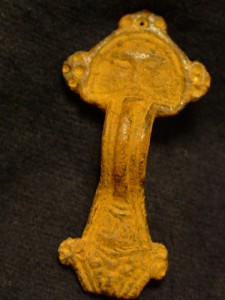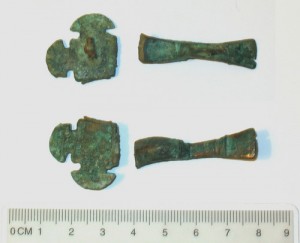August 1st, 2008 by Steve Ashby
Hello! Yes, it’s me, Barry Scott. Rapidly following on from last week’s Roman extravaganza, I thought I’d give you a brief introduction to what we’re finding out about what archaeologists refer to as the sub-Roman and Early Saxon periods.
The conventional wisdom is that following departure of the Roman legions (historically dated to AD 410), the infrastructure of Roman Britain rapidly disintegrated coins fell out of regular use, roads became potholed, overgrown, and eventually unused, and the effort required to maintain many villas was seen as unworthwhile. Don’t say that to my colleague, Rob Collins though. The long and short of it is that something (or nothing) happens in the immediate post-Roman period, and at the moment, we don’t know what that something or nothing was. Answers on a postcard. Before we get onto the PAS data, I’ll very quickly review some of what we know about settlement, agriculture, industry, and religion in the period of interest. Then we can get on to thinking about how PAS data can help to answer these questions.
Settlement and Agriculture
In Northants, extensive survey work carried out by Northamptonshire Archaeology in the east of the county shows evidence for population decline following Roman withdrawal, with a decrease in the density of settlement, an apparent dereliction of previously cultivated land, and the regeneration of woodland. Nonetheless, there is still much to learn about the rreasons for this trend, the means by which it happened, and the importance of egional variability. Together with traditional archaeological excavation and environmental research, PAS data can help clarify the important issues associated with this time period. Because our data is dominated by metalwork, we may miss some of the finds recovered by archaeological excavation, but our rural focus also means that we are working in areas many other archaeologists are not. It is only through bringing together these diverse sources of data that we can hope to understand what was going on in this poorly understood and understudied period.
However, the issue of the importance of the arrival of settlers from Anglia, Saxony, and Jutland is in many ways as contentious as that of the Roman withdrawal, and one in which metal-detected data may be able to play a more central role. How much of ‘Anglo-Saxon’ culture actually owes its existence to these settlers, and how important were the remaining native Britons? We can’t agree on the numbers of settlers, even in vague terms, and this is an issue that detecting may once again be able to help with; let us know when you’re finding Late Roman buckles or Anglo-Saxon brooches, and we will be better equipped to answer these questions. Even pay attention to grotty bits of pottery; there are some of us that love late Roman and early medieval ceramics (yes, honestly).
Industry
Taking a lead from their Roman forebears (and this is one of the hints at continuity following the AD410 military withdrawal) the inhabitants of Anglo-Saxon Northants developed a significant iron smelting industry, which was to last well into the Late Saxon (Viking) and medieval periods. Now, this is perhaps an area best left to the archaeologists, as the identification and dating of iron waste is a tricky (nigh impossible) task when context data is not available, and the constant pinging of iron slag is not a sound coveted by many detectorists. Base metal and ceramic industries were also important, and the recognition of local variation in these crafts is only identifiable through the collection of large numbers of artefacts with good findspot data. So we’d really like to know about any objects you do find. Some examples of the sorts of things that have already been recorded with us are given below.
Religion
To put it simply, paganism (for wont of a better term) seems to have ruled in Northamptonshire between the 5th and late 7th centuries, with over 50 pre-Christian cemeteries known. The artefacts found in these burials, including the ceramic urns used in cremations, and brooches and dress accessories deposited as grave goods in inhumation burials, seem to indicate that the settlers of Northamptonshire had diverse origins within Germanic Europe. The move to Christianity is a complex one, and one we’ll save for a future blog entry.
Summary
All of this evidence comes from a mixture of historical sources, excavation, geophysics, fieldwalking, conjecture and educated guesswork. What can metal detected data actually add to the picture?
Well, one area in which it shows great potential is in understanding the importance of tribal identities and regionality in post-Roman Britain. Recent work by Stuart Laycock on the distribution of late Roman and early Saxon metalwork has led him to suggest that Britain after the Romans was a complex, ununified system of tribes and enclaves; a picture perhaps analagous to the Balkans in the late 20th century. Such a scenario would be easily exploited by invading Angles, Saxons, and Jutes. This idea is not yet proven, but metal-detected data has played a fundamental role in its development, and will continue to be important in discussion and debate around the subject. What was the situation in Northants, part of the region dominated by( prior to the Roman arrivals, and perhaps after their withdrawal) a tribe known as the Corieltauvi, for example? We need more research to find out, so please keep recording your finds with us, with as precise findspot data as possible.
Supporting-Arm Brooch
The first evidence of migrants comes from a couple of very early, continental-style brooches. This supporting arm brooch dates to around the late 5th-century, and clearly still wears its Roman influence on its sleeve. Importantly, it is a rare type in Britain, but is more well-known in the Germanic homelands of Schleswig-Holstein, northern Germany. Tantalisingly then, it might therefore have arrived in Britain on the clothes of one of the first Anglo-Saxon settlers.

Radiate-headed Brooch
Slightly later in date is this radiate-headed brooch, which dates to around the 6th-century, and has its closest parallels in continental Europe. It may betray a Frankish influence in the area. Though it is difficult to prove as much on the basis of a single find, it does raise the question. As such, the archaeological importance of recording these metal-detected artefacts and their findspots is clear. When we have enough data to map it, distribution analyses may considerably chnge our understanding of life and death in Northamptonshire in the wake of the Roman withdrawal and the first years of Germanic settlement.
An Anglo-Saxon Small-Long Brooch from Northamptonshire
From the main period of the Early Anglo-Saxon period, we have a number of suggestions of Anglo-Saxon cemeteries, and others which are probably related to previously known (and now sadly largely lost) gravefields. That is, if we can take these brooches as evidence of cemeteries; perhaps some are chance losses related to settlement activity and travelling? This suggestion has been made by the Anglo-Saxon brooch project, run by our former Kent FLO, Andrew Richardson and Laura MacLean (Essex FLO).
Similar research is being undertaken by a number of archaeologists, not least our own Drs Kevin Leahy and Helen Geake. I’m sure details will appear here as various projects progress.
